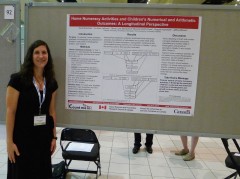
University of Alberta
Posters:
Home Numeracy Activities and Children’s Numerical and Arithmetic Outcomes: A Longitudinal Perspective
Sowinski, Carla; LeFevre, Jo-Anne; Skwarchuk, Sheri-Lynn; Smith-Chant, Brenda; Kamawar, Deepthi; Bisanz, Jeffrey
Researchers have found that home numeracy experiences predict young children’s numeracy skills but little research has examined the impact of home numeracy experiences over time. We used a longitudinal design to examine links between parents’ home numeracy practices and children’s numeracy skills in Kindergarten, Grade 1, and Grade 2. At the start of the study, parents (n = 104) reported the frequency of home numeracy activities; these activities were separated into direct and indirect practices. Direct numeracy practices involve purposeful teaching of math or number concepts (e.g., learning simple sums), whereas indirect numeracy practices include a numerical component that is not the focus of the activity (e.g., measuring while cooking). Children participated in Kindergarten (n = 104, 49% female), Grade 1 (n = 91, 46% female) and Grade 2 (n = 71, 45% female). Each year, children completed (a) arithmetic tasks (addition in Kindergarten and Grade 1; Woodcock-Johnson calculation in Grades 1 and 2); and (b) number skill measures: KeyMath Numeration, digit recognition and next number tasks (these three were combined to create a composite number skill variable for each grade). Direct home numeracy practices in Kindergarten significantly correlated with children’s number skills and arithmetic performance in Kindergarten, Grade 1 and Grade 2, whereas indirect home numeracy practices were only correlated with calculation in Grade 2. Hierarchical regression analyses examined Kindergarten numeracy practices as a predictor of children’s skills in Grades 1 and 2, controlling for parents’ education and children’s gender, vocabulary, visual-spatial working memory and the previous years’ skill. For Grade 1 number skills, direct home numeracy practices failed to predict unique variance once Kindergarten number skills were included as a predictor. However, in Grade 2, direct home numeracy practices uniquely accounted for 2% of the variance in Grade 2 number skills (p = .059; controlling for Grade 1 number skills). Analyses of calculation skills showed a different pattern. In Kindergarten, direct practices predicted 5% unique variance in addition skills. In Grade 1, direct practices predicted 4% unique variance in calculation (controlling for addition in Kindergarten). However in Grade 2, direct practices did not predict unique variance after controlling for calculation in Grade 1. Instead, indirect practices accounted for 5% of the variance in Grade 2 calculation. Future research should explore whether or not it is simply early exposure to specific numeracy activities, ongoing home learning activities, or both, that account for these findings.
Exploring the Roles of the Number Naming System and Early Experiences in the Development of Numeracy: A Comparison of Chinese- and Turkish-speaking Children
Cankaya, Ozlem; Xu, Chang; LeFevre, Jo-Anne;
Chinese-speaking children learn about number names and counting at younger ages than English-speaking children. One factor may be that the Chinese number naming system is simpler than in English. For example, twelve is named as the equivalent of ten-two and thirty-five is three-ten-five. The Turkish number naming system is similar to Chinese between 11 and 19, but from 20 on resembles English. Given this, one might expect Turkish-speaking children to have some advantages in learning number names from 1 to 20, similar to those shown by Chinese-speaking children. However, educational experiences at home (e.g., the amount of practice) are also relevant. In China, numeracy skills are highly valued and children spend considerable time practicing these skills. In contrast, mathematics education in Turkey is not emphasized to the same degree as it is in China. Thus, a comparison between Turkish and Chinese children may clarify the relative effects of language and children’s home experiences on early numeracy development. Turkish- or Chinese-speaking 3-, 4-, 5-, and 6-year-olds were tested in Ottawa, Canada. Children’s early numeracy skills were explored in Turkish (n = 20) or Chinese (n = 22), and children counted as high as possible in English. Chinese-speaking children’s counting and number system knowledge in Chinese were superior to that of Turkish-speaking children’s knowledge in Turkish whereas children’s spatial span, non-symbolic arithmetic, object counting, and abstract counting in English were not different between language groups. Parents’ attitudes and reported actions differed: Chinese parents attributed more importance to the acquisition of literacy and numeracy skills, and reported that they exposed their children to reading and books more frequently than did the Turkish parents. Parents’ attitudes predicted children’s performance on counting and number system measures, even after group differences were accounted for. However, neither language nor home experiences predicted children’s performance in non-symbolic arithmetic. In conclusion, the regularity of number names did not appear to help Turkish-speaking children learn to count to 20, at least in comparison to Chinese- speaking children. The Chinese number naming system continues to be regular beyond 20, however, and so some of the language-group differences may reflect that continued regularity. Our research suggests that the influence of cultural differences in parents’ attitudes and expectations about early numeracy and literacy skills are as relevant in understanding children’s acquisition of number system knowledge as language- specific effects. View Poster

Carla Sowinski at the Poster Session